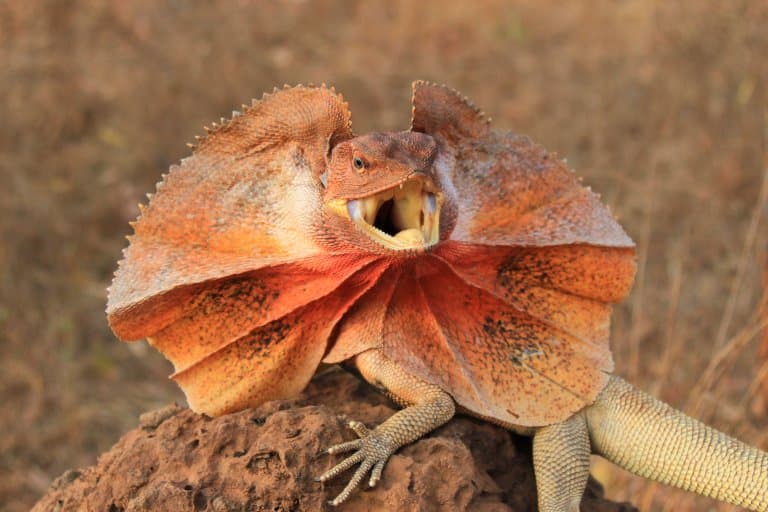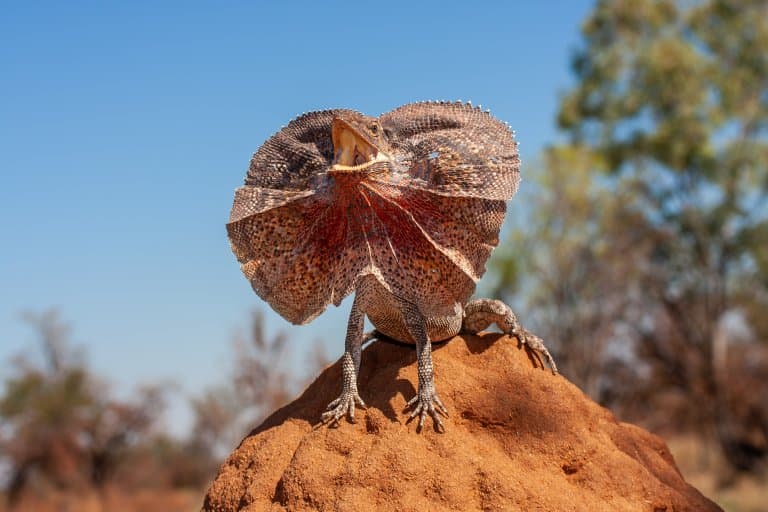Frilled Lizard Profile
This animal inspired one of the most iconic dinosaur interpretations of the ‘90s.
In Jurassic Park, Dilophosaurus was seen to be able to expand its neck skin and spit venom, neither of which was a talent inferred to exist in the dinosaur by palaeontologists.
But the frill served a brilliant cinematographic purpose in the movie, and the frilled lizard it came from should not be at all surprised. It is, after all, a visual representation of a substantial amount of information.
The frilled lizard, also known as the frilled-necked lizard, frillneck lizard, or frilled dragon is a species of lizard native to northern Australia and southern New Guinea.

Frilled Lizard Facts Overview
| Habitat: | Savannah, dry, grassy woodlands |
| Location: | Australia and Southern New Guinea |
| Lifespan: | More than 20 years in captivity |
| Size: | Up to around 90cm (3ft) |
| Weight: | Up to 600g (1.3lb) |
| Color: | Varies between grey, brown, or black |
| Diet: | Insects and other invertebrates |
| Predators: | larger lizards, snakes, birds of prey |
| Top Speed: | Unknown (not 30 mph!) |
| No. of Species: | 1 |
| Conservation Status: | Least Concern (IUCN) |
It’s name unsurprisingly comes from the large frill around its neck, which is usually folded against its body.
While it can’t spit venom like the Spielberg interpretation, the frilled lizard does has some alarming defences. Its characteristic display tells a lot about it and gives the lizard the ability to be both camouflaged and strikingly present, depending on the situation.
Frilled lizards primarily feed on insects and other invertebrates, such as ants, termites and centipedes. They will also take the odd vertebrate.
These large, tree-dwelling long-lived lizards are well adapted to the intense heat of the Australian bush and conserve energy in clever ways.
Interesting Frilled Lizard Facts
1. What’s with the frill?
First of all, the colouration gives the viewer clues about the nutritional content of the animal’s food.
Orange frills suggest it’s been eating more carotenoids, and yellow or white imply a lack of certain pigment cells, called pterins, which not only make animals brightly coloured but also have a major role in various biological functions.
A yellow frill is linked to steroid concentration, which might suggest something about the lizard’s hormone cycle and temper.
So, a lot is going on in this display, and as with many colour-based mating actions, flapping this vibrant skin at a female or rival lets them know what she’s getting herself into. 1 2

2. They are most active during the day
There isn’t much point in using color if you’re only going to be doing things in the dark. So, it’s safe to assume that an animal looking this dolled-up is hoping for someone to see it.
Having said that, “active” is a generous term to use. “Awake” might be more accurate for these lizards, who like to sit on a rock or in a tree all day and wait for an opportunity to show off.
And while they have fantastic coloration when they need it, they’re actually remarkably camouflaged when they don’t. They spend much more time in the trees than on the ground, but there isn’t so much food there, so they will come down to feed.
3. They are arboreal
Since they spend up to 90% of their time up trees, they’re known to biologists as arboreal. But living in trees comes with its handicaps. Meeting other lizards is difficult enough, but being unable to get down from your tree would mean you’re stuck with the same neighbours, day in and day out.
Feeding time is also tricky. Termites and centipedes and other creepie crawlies do climb trees, but they’re much more prevalent on the ground.
So, the lizard reluctantly comes down, more so in the wet season, to feed, mate, socialise and fight.
During mating season, males are particularly active, averaging up to a very appropriate 69 meters per day in pursuit of some loving. 3

4. They flash for a variety of reasons
The hyoid bone in humans is the only bone that isn’t connected directly to any of the others, being held in place by a series of muscles and is useful for supporting tongue and laryngeal movements when talking, swallowing and breathing.
In the frill-necked lizard, it’s responsible for thrusting out the dazzling flap of skin that gives the animal its name, and this plays a role in more than just mating.
When it’s time to argue over territory or females, the male frill-necked lizard will issue a sincere threat display, widening its frill to maximum capacity and opening its mouth.
This is also used to deter predators, and if that doesn’t work, they can hiss.
There are even some suggestions that it can even aid in hearing, acting like a sound cone. 4
5. Their run is hilarious
Lizard locomotion is generally quite inefficient due to how long and bendy they are, and how stiff their shoulder joints are. This leads to what amounts to an embarrassing urgent wiggle in most cases of escape, but the frill-necked lizard has a solution to this.
If all the flapping and hissing fails to slow down a scary altercation, the lizard has one more trick up its sleeve.
Bipedal skedaddling is not yet a fully recognised term, as of writing this, but there’s no better way to describe it. The lizard will stand on its back legs, lean back, open its mouth and charge. Either toward or away from the opponent, depending on the context.
They’ll even do this for foraging, which is as-yet unseen in other lizards. Their extended neck counterbalances them, making them particularly efficient when running on two legs.
6. They’re hot!
And not just around the neck.
One of the things you might have heard about Australia is that it’s bloody hot (mate). This heat gets into everything and makes it impossible to find a cool space to regulate your body temperature.
And this would be a concern for plenty of animals who want to keep their internal body temperature below the very cool and collected 37°C that we’re used to.
Frill-necked lizards don’t fret this stuff, and commonly go with the flow, reaching internal temperatures of up to around 40°C.
This saves a huge amount of resources because they don’t need to move or sweat, and therefore don’t need to eat or drink as much to compensate for that. 5
7. They’re iconic in Australia
Along with the kangaroo and koala, the frilled lizard is regarded as one of Australia’s most iconic species and has been featured on coins, as well as on TV and in the media.
Frilled Lizard Fact-File Summary
Scientific Classification
| Kingdom: | Animalia |
| Phylum: | Chordata |
| Class: | Reptilia |
| Order: | Squamata |
| Family: | Agamidae |
| Subfamily: | Amphibolurinae |
| Genus: | Chlamydosaurus |
| Species: | Chlamydosaurus Kingii |
Fact Sources & References
- Claire A. McLean (2019), “Red carotenoids and associated gene expression explain colour variation in frillneck lizards”, NIH.
- Pedro Andrade (2021), “Pterin-based pigmentation in animals”, The Royal Society.
- Richard Shine (1989), “Ecology of Frillneck Lizards, Chlamydosaurus kingii (Agamidae), in Tropical Australia”, Sci Hub.
- John Peacock (2022), “The acoustical effect of the neck frill of the frill-necked lizard (Chlamydosaurus kingii)”, The Journal of Acoustic Society of America.
- R Shine and R Lambeck (1989), “Ecology of Frillneck Lizards, Chlamydosaurus-Kingii (Agamidae), in Tropical Australia”, Australian Wildlife Research.
